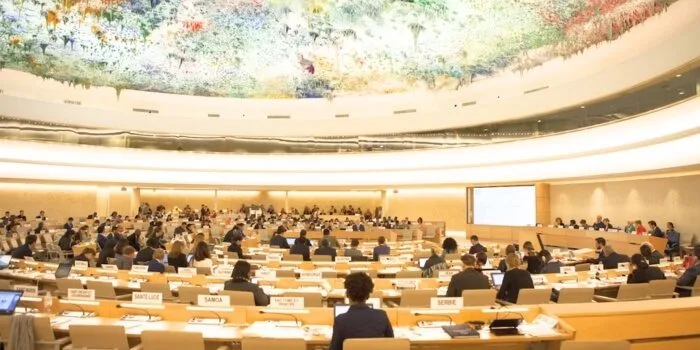The decision between a television and a projector when designing a conference room is crucial because it affects how well presentations and meetings go. There is no universal answer to the topic, “Is a TV or projector better for a conference room?”
It depends on a few things, like the room’s dimensions, the number of guests, and the available funds. Televisions perform best in well-lit areas because they provide excellent clarity and detail. On the other hand, because of their wide display capabilities, projectors can accommodate larger audiences, however, they do require dimmer lighting to enhance visibility.
To help you make the best decision for your conference room, this article explores these factors. To learn more about the advantages and disadvantages of each choice, keep reading.
The Core Purpose of the Conference Room
The core purpose of conference rooms is to facilitate collaboration within an organization. They serve as spaces where ideas merge, strategies unfold, and decisions are made. Effective teamwork and communication are vital in these rooms, making them essential for productive interactions among team members.
Conference rooms are designed for sharing knowledge and solving problems collectively. They host various activities, such as training sessions, meetings, and casual gatherings that encourage cooperation. Their versatility allows them to adapt to different functions, making them valuable assets in today’s workplace.
Conference rooms are equipped to enhance focus and efficiency. With comfortable seating and modern technology, these spaces promote active participation and engagement. A well-designed conference room can significantly influence the success of many projects and initiatives. By providing an environment conducive to collaboration, conference rooms help teams achieve their goals and drive organizational growth.
Essential Requirements for Setting Up a Conference Room
Comfort and effectiveness must be carefully considered while setting up a conference room. It’s all about setting up an environment where communication is easy and ideas may flow. Here’s how you strike the ideal balance:
- A reliable, high-speed internet connection is crucial for seamless video conferencing and online research during meetings. It ensures that presentations run smoothly without any frustrating interruptions.
- Quality audio-visual equipment like a TV or projector for conference room and sound system, makes presentations engaging and allows everyone to participate fully. This setup enhances the effectiveness of communication among participants.
- Comfortable seating arranged to encourage eye contact and interaction promotes a collaborative atmosphere. It’s important for maintaining focus and engagement throughout meetings.
- Adequate lighting, preferably natural supplemented with adjustable artificial options, creates a conducive environment for both concentration and comfort. It helps to reduce eye strain during long sessions.
- A whiteboard or flip chart is essential for brainstorming sessions and spontaneous idea sharing. These tools support visual thinking and facilitate a better understanding of concepts.
- Efficient climate control keeps the room at a comfortable temperature, making it easier for attendees to concentrate and stay productive. This aspect often goes unnoticed but is vital for comfort and attentiveness.
The key to designing the ideal conference room arrangement is to combine comfort and technology. For a productive workstation, these components are essential, since decisions are made here and innovation is fostered.
Is a TV or Projector Better for a Conference Room?
To improve meeting experiences, choosing between a TV and a projector for a conference room is essential. Collaboration efficiency and presentation quality are both significantly impacted by this decision. But when organizers want to spend for one, they often raise questions like, “Is a TV or Projector Better for a Conference Room?” Let’s look at the factors that should affect this decision.
Room Size and Audience
A projector suits larger rooms and audiences, offering a wide display that everyone can easily view. TVs, however, are ideal for smaller settings where clarity and detail are paramount. The size of your room directly influences the effectiveness of these devices. In expansive spaces, a projector’s large screen ensures visibility, while TVs excel in intimate settings.
Lighting Conditions

Budget Considerations
Projectors can be more cost-effective for larger displays compared to similarly sized TVs. However, high-quality projectors that offer brightness and clarity similar to TVs might increase the budget. TVs might offer more value with their durability and lower maintenance costs. It’s essential to balance initial costs with long-term value and maintenance expenses.
Ease of Use and Maintenance
TVs are generally easier to set up and require less maintenance over time, offering convenience and reliability. Projectors, while offering a larger display, may require regular maintenance like bulb replacement. The ease of connecting devices and seamless integration play a crucial role in choosing TVs for tech-heavy environments. Projectors might need calibration and adjustments, adding to their upkeep.
Resolution and Image Quality
TVs typically provide superior image quality and resolution, important for detailed presentations and videos. Projectors can offer good quality but might fall short in comparison, especially in bright rooms. High-resolution projectors are available but come at a premium. For crystal-clear images and texts, a high-quality TV is often the better choice.
The correct option will take your meetings to the next level, whether it’s the crisp clarity of a TV or the immersive experience of a projector.
Pros and Cons of Using TV in A Conference Room
The standard of presentations and meetings can be greatly improved by adding a TV to a conference room. This technology facilitates teamwork by combining ease of use and clarity. A fair assessment of its benefits and drawbacks may be found here.
Pros of Using TV in A Conference Room
- High Resolution: TVs provide crisp, clear images, enhancing the visual quality of presentations.
- Ease of Use: Simple setup and operation make TVs accessible for all users.
- Reliable: Less prone to technical issues, ensuring consistent performance.
- Versatile Connectivity: Easily connects to various devices, supporting multiple presentation formats.
- Brightness: Performs well in brightly lit rooms, eliminating glare issues.
Cons of Using TV in A Conference Room
- Size Limitations: Larger screens can be expensive, restricting size options.
- Fixed Position: Once mounted, TVs offer less flexibility in adjusting viewing angles.
- Power Consumption: Larger TVs can consume more electricity, increasing operational costs.
Choosing a TV for your conference room brings a mix of benefits and drawbacks. It’s about finding the right balance for your specific needs, and ensuring meetings are both productive and engaging. However, you need to choose the best seating style among the different styles of conference seating to let the attendees enjoy the visualization on TV or Projector.
Pros and Cons of Using a Projector for a Conference Room
The efficiency of presentations and group projects can be significantly impacted by the selection of visual aids for a conference room. A popular option because of their scale and flexibility are projectors.
The following are the main advantages and disadvantages of using a projector in a conference room.
Pros of Using a Projector for a Conference Room
- Large Display Size: Projectors can produce a massive screen size, ideal for large groups.
- Flexible Installation: Adjustable screen size and placement cater to different room layouts.
- Cost-Effective: Offers a larger display per dollar compared to TVs.
- Portable: Some models are portable, allowing for versatile use across different rooms.
- Ambiance: Creates a theater-like atmosphere, enhancing presentation engagement.
Cons of Using a Projector for a Conference Room
- Lighting Requirements: Best viewed in dimly lit rooms, which may not always be practical.
- Maintenance Needs: Bulbs and filters require regular maintenance or replacement.
- Potential Quality Compromise: Higher quality models can be expensive, with cheaper options potentially lacking in resolution and brightness.
Projectors are ideal for dynamic presentations and engaging large audiences because they provide a scalable and immersive viewing experience for conference rooms. But care, lighting, and image quality are practical matters that need to be properly examined.
How Room Size Affects Your Display Choice
When deciding between a TV and a projector for your conference room, room size plays a crucial role. In larger rooms, projectors are often the better choice. They can display a bigger image, making it easier for everyone to see the presentation. A projector can fill a large wall or screen, which is helpful for meetings with many participants.
On the other hand, smaller rooms typically benefit from a TV. TVs provide high-quality images that remain sharp and vibrant, even at close distances. In a smaller space, a large TV can be just as effective as a projector, without needing to worry about the issues that can come with projectors, like brightness or image clarity.
Additionally, room layout is essential to consider. If your conference room has a lot of natural light, a projector might struggle to provide a clear image unless you invest in a high-quality, bright model. In contrast, TVs usually perform well in various lighting conditions. Ultimately, assessing your room size and layout will guide you in choosing the right display option for effective communication in your conference room.
Frequently Asked Questions
In this section, we address common questions regarding whether a TV or projector is better for a conference room. Understanding these differences can help you make an informed decision based on your space and needs. Here are some frequently asked questions along with their answers.
What Size of Room Is Ideal for A Projector Setup?
Projectors are typically better suited for larger rooms where a bigger screen size is necessary. They offer flexibility in display size without compromising image quality. In a spacious environment, projectors can project clear images that are easy for everyone to see. For smaller rooms, however, a TV may be more practical and effective.
Are Projectors More Cost-Effective than TVs for Conference Rooms?
In terms of upfront cost, projectors can be more budget-friendly, especially for larger screen sizes. This makes them an attractive option for organizations looking to save money initially. However, ongoing maintenance, such as replacing bulbs, can incur additional expenses over time. Therefore, it’s essential to consider both initial costs and long-term maintenance when making your choice.
How Does Ambient Light Affect the Choice Between a TV and A Projector?
TVs perform better in brightly lit rooms as they have higher brightness levels and can maintain image quality regardless of ambient light. Projectors, on the other hand, may struggle to compete with ambient light, resulting in diminished image clarity.
Can Projectors Offer the Same Image Quality as TVs In a Conference Room Setting?
While projectors have made significant advancements in image quality, particularly with higher resolutions and improved contrast ratios, TVs generally provide sharper and more consistent image quality, especially in controlled lighting environments.
Which Option Provides Better Flexibility for Presentations and Multimedia Content?
Projectors offer greater flexibility in terms of screen size and aspect ratio, making them ideal for presentations with diverse multimedia content. TVs, however, may offer more seamless integration with other conference room equipment and technology.
Bottom Line
In our exploration of the ideal visual solution for conference spaces, we’ve been guided through various considerations that influence whether a TV or Projector is the superior choice. Determining “Is a TV or projector better for a conference room?” relies on assessing room size, audience capacity, lighting conditions, budget constraints, and the desired quality of presentations.
Televisions shine in smaller, well-lit areas with their unparalleled clarity and ease of use, making them a solid choice for detailed content sharing. Conversely, projectors excel in larger spaces, offering expansive display sizes and a captivating viewing experience, albeit with additional maintenance considerations.
By matching your choice to the particular requirements of your conference room, you can make sure that meetings are interesting and productive as well as collaborative and imaginative.







